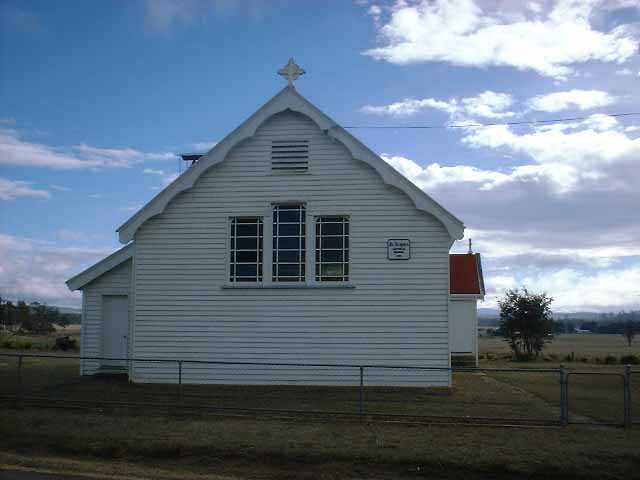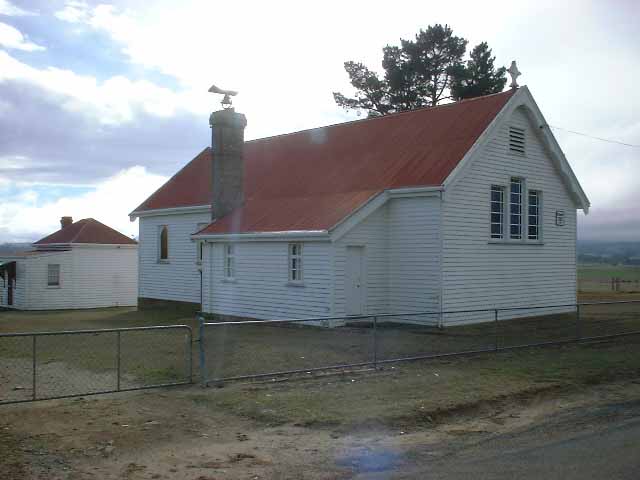22 Scotts Rd, Tunnack. Google Maps.
Opened 1894.
TUNNACK R C. CHURCH
Thriving Community
Convent and School
About 70 years ago, when Father Keohan was parish priest, the first Roman Catholic Church was built in the Tunnack district. It was only a small structure, measuring 30ft by 15ft. It was used as a church and school combined, and was erected more than a mile from the centre of’ Tunnack, though within the town boundary, for here, as in other centres in the Midlands, the pioneers made every preparation for expansion, which has not yet been realised fully. The church was erected on a glebe block of land granted by the Government in the early days, and adjoining it were a cemetery and a three-roomed residence in which the school teacher resided until the arrival many years later, of the Sisters of the Church.
In the last decade of the nineteenth century it was decided to build a new church at Tunnack, and on blocks of land donated by the late Mr. Charles Owen O’Conor (whose two sons, Messrs. Alex and Patrick O’Conor, and three daughters still reside in the district) a church and convent were erected. It was considered that the convent would be of more service at Tunnack than at Oatlands, where it had been previously, owing to there being a larger Roman Catholic community in the Tunnack district.
The present church is a weatherboard structure which recently has been re-roofed with galvanised iron. On the same block is a portion of the old church which was moved from its original site en bloc, and is now used by the sisters as a washhouse. Nearby are the convent and school, erected just after the war and both of weatherboard. The school consists of two, rooms, and accommodates over 60 children, who are taught by the three sisters residing at the convent. Tunnack, at present, has not a parish priest of its own, but its needs are cared for by Father Barry, of Oatlands; who makes frequent visits to the district.
The Mercury, 28 July 1930
Notice is given that, on the application of Bishop Murphy, the Governor-in-Council has approved of certain land in the township of Tunnack being reserved as a site for a church, minister’s house, school, and burial-ground in connection with the Roman Catholic community.
The Mercury, 11 September 1866
TUNNACK.
[From a Correspondent.]
On Wednesday last the Bishop of Hobart Town paid his first visit to this place. His Lordship was accompanied by Dr. Murray, Bishop of Maitland, New South Wales, and the Rev. J. Feehan, the pastor of the district. On the arrival of their Lordships here they were met by a large number of the inhabitants, who assembled to receive the Bishop on this occasion. The day was very fine, with a gentle west wind blowing ; and notwithstanding that the road from here to Oatlands is anything but good to ride or drive over, the party arrived in good spirits, not much the worse after a journey of 15 miles, performed before noon. After a short stay at Mr. O’Connor’s, the Bishop of Hobart Town, accompanied by Father Feehan and others, drove to the Catholic Church, where a concourse of people were assembled to greet his Lordship on his arrival. The approach to the chapel for several yards was strewn with flowers and evergreens, as a mark of respect to his Lordship on his first visit, this being the act of the good ladies of Tunnack, for which, indeed, they deserve thanks.
After prayers being said by his Lordship and those assembled, he delivered a short but eloquent discourse on sin, its origin, and consequences. After entering fully into the subject, he next alluded to the little church, and in his remarks said it was the worst he ever saw. It is by far too small for the congregation which has considerably increased for the last few years, and in appearance it is anything but a house suitable for the worship of God. On His Lordship quitting the little church he was greeted with three hearty cheers from all assembled. The whole party then drove back to Mr. O’Connor’s, who has given a site for a new church, and their Lordships selected the spot upon which the Tunnack Roman Catholic Church is to stand ; and although there is no visible rock, I am quite satisfied it will stand upon the same rock upon which Christ built His Church, and that the “gates of hell shall not prevail against her.”
Now that the good work is cut out it is to be hoped that parties whose business it is to carry on will not delay longer than is needful for the work begun is half done. After another short delay their Lordships and Father Feehan left for Oatlands at 4 o’clock where they arrived safely and in good spirits, after performing a good work, and a rough journey of over 33 miles of bad roads. >It is to be hoped that his Lordship’s next visit is not far distant, when the ceremony of laying the foundation stone will take place.
The Mercury, 3 December 1877
Tunnack.-In our advertising columns we note that on New Year’s Day will be laid the foundation stone of a new church for the Roman Catholics at Tunnack. This is a move in the right direction, as really the old slab edifice used for church there was not only out of the way of the majority of the congregation of that denomination, but also discreditable to them now, considering their number. Of course, in Auld Lang Syne, when they were few and poor, it was a boon, as, “beggars can’t be choosers;” but we like to see each denomination with a temple of expense and style equal to its means and numbers. The new church, we are informed, is to be of free stone, and according to plans made by Mr. Hunter. We hope to be able to chronicle good results after the ceremony of the foundation stone. Every Roman Catholic at Tunnack ought certainly “come out strong” on the occasion, and we have no doubt but that neighbours of other denominations will help on the good work.
The Mercury, 24 December 1881
On Saturday last His Lordship Bishop Murphy was expected at Tunnack to administer the rite of Confirmation there, and to lay the foundation-stone of a new Catholic church.
The Mercury, 6 January 1882
Tenders were opened to-day for the erection of a Catholic church at Tunnack, and that of Mr Upchurch, at £280 5s, was accepted. The architect’s estimate was £330. The highest tender was Howell Bros , £425.
Daily Telegraph, 11 January 1894
CENTRAL BOARD OF HEALTH
PUBLIC BUILDINGS.
The secretary reported that the necessary alterations were being made to the Catholic Church, Tunnack, and that the Salvation Army Barracks at Ulverstone complied with the regulations. The opening of both buildings was approved by the Board
18 August 1894
OPENING OF A NEW CHURCH.
OATLANDS, SUNDAY.
The new Catholic Church of St. Bridget’s, at Tunnack, was opened to-day, and despite the bad weather a crowded congregation was present. Bishop Delany delivered an eloquent sermon, and the results of the collection were about £105. The congregation presented an address of welcome to Bishop Delany, and throughout the proceedings were most satisfactory. Large contingents came from Oatlands, Parattah, and Jerusalem, although the weather was wretched until about 9 o’clock.
The Mercury, 9 July 1894

